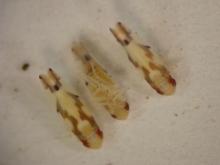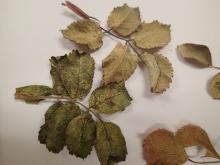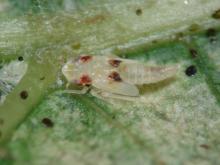Includes Cicadomorpha spp.
Pest description and damage Several species of leafhopper may attack ornamental plants. Leafhoppers are slender, delicate insects about 0.125 inch or less in length. They are distinguished by the adult hopping or flying to escape danger, and by the ability of nymphs and adults to run forwards, backwards, or sideways easily. Leafhoppers have piercing-sucking mouthparts that they use to suck the contents out of surface plant cells. Leafhopper feeding damage to leaves includes small white to yellow stipples, yellowing, or leaf curling. Small amounts of this stippling are not injurious to the plants, although sometimes the tips of host plant leaves die and turn brown. Leafhoppers often exude copious amounts of honeydew. Commonly attacked ornamental plants include aster, calendula, gladiolus, dahlia, hollyhock, marigold, rhododendron, rose, and zinnia. Some leafhoppers transmit virus diseases to susceptible crop plants.
Biology and life history Varies with the species. Leafhoppers may overwinter as adults, nymphs, or eggs. There may be two or three generations per year.
Pest monitoring Yellow sticky cards or double-sided tape wrapped around small branches or twigs can be used to monitor for leafhoppers.
Management-cultural control
Use of row cover fabric in early summer can exclude leafhoppers from small shrubs. Yellow sticky traps are attractive to, and entangle, leafhoppers and other insect pests.
Management-biological control
Leafhoppers have many natural enemies, including lady beetles, lacewings, damsel bugs, and spiders. They are also subject to diseases and parasites that keep their numbers low under most circumstances.
Management-chemical control
See Table 1 in:




